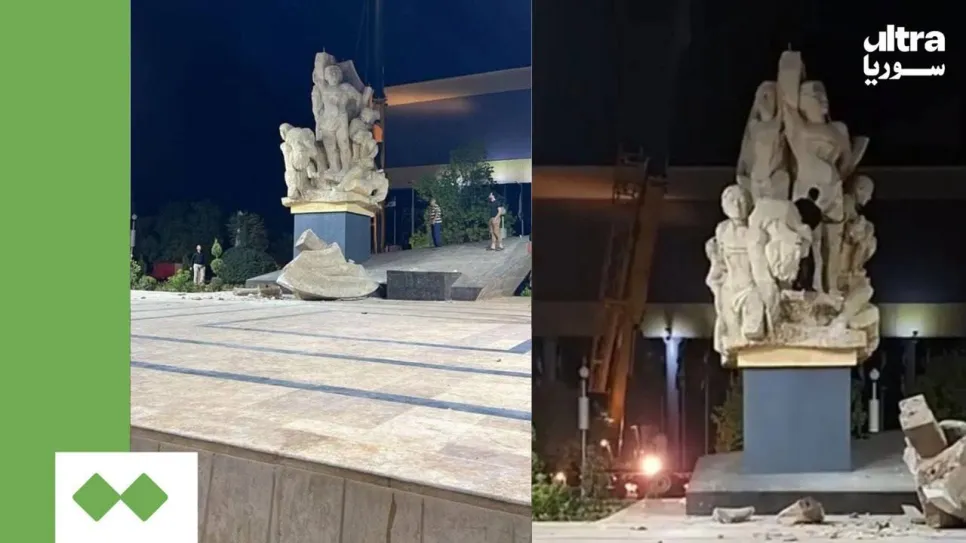A wave of public anger erupted on social media after a video surfaced showing the removal of the “Martyrs’ Statue” from Saadallah al-Jabiri Square in central Aleppo. The footage documented the statue being pulled down in a crude, unprofessional manner, resulting in significant damage and sparking fears that restoration may be difficult or impossible.
The widely circulated clips showed the statue being yanked with ropes in a haphazard way, causing it to snap in half and collapse. The upper section shattered upon impact, drawing condemnation from heritage experts and citizens alike for what many viewed as cultural negligence.
Official Response: Damage Control
In response to the backlash, Aleppo’s Directorate of Antiquities and Museums issued a statement claiming that the removal was part of a broader redevelopment plan for Saadallah al-Jabiri Square. The statement said the statue was relocated to a different location for preservation and future restoration by specialists.
It also explained that the statue was moved to “make the square more suitable for public events,” particularly after a large video screen was installed in the area, which the statue partially obstructed.
Aleppo Governor Azzam Gharib condemned the execution of the removal operation, calling it “unacceptable by any standard.” He pledged accountability, stating that “the implementing party violated the agreed technical and construction protocols,” and confirmed that an immediate investigation would be launched to hold those responsible to account.
Gharib also denied rumours of ideological motivations behind the statue’s removal, asserting instead that it was an administrative decision rooted in urban planning and public feedback. He added that the damaged parts would be restored and the statue would be preserved in a museum “in accordance with proper procedures.”
A Symbol Under Threat
However, local sources told Al-Tareeq Syria that the statue’s removal had been a contentious issue since the fall of the Assad regime. Previous efforts to dismantle the statue were halted in the face of public resistance, due to the deep symbolic value the monument holds for Aleppans. The statue commemorates the martyrs of Aleppo who died during the French colonial era and is considered a central landmark tied to the city’s collective memory.
For many residents and observers, the careless handling of the statue reflects a broader disregard for cultural heritage and historical sensitivity. They argue that such monuments form vital emotional and historical links between past and present, especially in a city that has already endured widespread destruction and loss of identity over the past decade.
Scholars and Artists React
Cultural figures and researchers reacted sharply. Hussam Jazmati, a Syrian writer, commented on Facebook:
“Though I left Aleppo 12 years ago, I don’t recall anyone ever worshipping the Martyrs’ Statue, as a video from the demolition suggests, claiming it was an ‘idol carved by pagans decades ago.’”
Jazmati recalled meeting the statue’s sculptor, Abdul Rahman Mouaqet, at the Arab Scientific Heritage Institute at the University of Aleppo. He explained that the artist had traced his family name to a lineage of timekeepers responsible for calling prayers at the Great Umayyad Mosque — a detail that underscores the intertwining of heritage, spirituality, and craftsmanship.
Jazmati noted that the elderly sculptor had been seeking ancient manuscripts to relearn the art of traditional timekeeping, hoping to retire and devote himself to this craft within the mosque — a symbolic act of cultural continuity.
Meanwhile, political researcher Salam Kawakibi responded to the incident with biting sarcasm:
“The statue was removed because it ‘offended religious sensitivities’? What a historic achievement!” He added, “Apparently, electricity shortages, inflation, unemployment, and destruction have all been solved — only this ‘infidel statue’ remained.”
Kawakibi went on:
“Honestly, I feared the stone might one day rise and threaten public morality. But thank you to the ever-watchful authorities, whose only lullaby is the sound of smashing beauty. And thanks to religion — always ready to be weaponized whenever reason becomes inconvenient.”
He concluded:
“A statue in a square doesn’t shake anyone’s faith. But removing it shakes what remains of reason.”
This article was translated and edited by The Syrian Observer. The Syrian Observer has not verified the content of this story. Responsibility for the information and views set out in this article lies entirely with the author.


